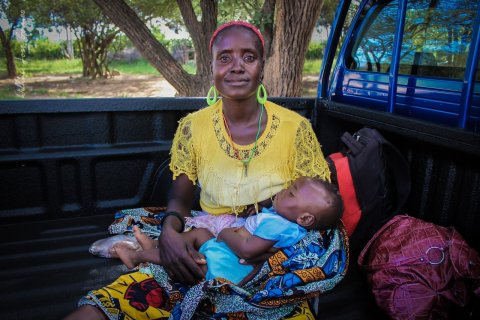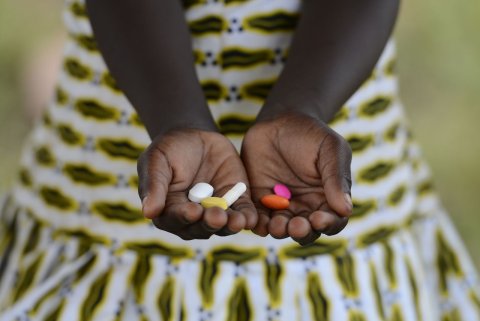Malaria: a reflection from the past, a gaze into the future
Malaria has had one of the longest histories of diseases known to humanity: first symptomatically described in 2700 BCE China in the ‘oldest known medical text’, Nei Ching, malaria continued – and continues – to plague populations across the globe.
Yet it was only in the late 1800s when malaria really became defined as we know it today – a fever-inducing, anaemia-causing disease, instigated by five species of the Plasmodium parasite in humans, and transferred by mosquito; potentially fatal, but also treatable and preventable.
The original definition of malaria came thanks to Charles Louis Alphonse Laveran, who first identified the Plasmodium parasite, and Sir Ronald Ross’ ‘beautiful discovery’ of the Anopheles vector, in correspondence with Sir Patrick Manson. That’s where RSTMH comes in.
Transactions of the Royal Society of Tropical Medicine & Hygiene has had a rich history of publications concerning malaria, starting with Cropper’s article on ‘pernicious malaria’ in its very first 1907-1908 volume, when the Society was led by President Manson and Vice-President Ross.
Since its first publication, Transactions has published over 3,800 malaria-related papers, and the 1980s in many ways saw the culmination of several polemic issues surrounding malaria: drug resistance, impact on pregnancy and the controversy of iron supplementation for anaemia.
Looking at three journal articles from the 1980s to now, we can see the encouraging progress that has been made in managing and controlling malaria.
A Thai tale: a study into Plasmodium falciparum antimalarial drug resistance in Thailand
The study by Thaithong and Beale in 1981 saw the collection of nine endemic central Thai P. falciparum isolates for in vitro testing with concentrations of chloroquine and pyrimethamine, against a tenth Gambian standard.
Basing their culture method off Nguyen-Dinh and Trager’s 1978 resistance study, Thaithong and Beale cultured the parasitised cell isolates for inoculation of different drug dosages. Following incubation, the generation of Giemsa-stained thin blood films enabled visualisation of parasite density.
Thaithong and Beale’s study found that the nine Thai isolates were much more resistant to both chloroquine and pyrimethamine than the drug-sensitive Gambian isolate: about 10 times more resistant to chloroquine, and an alarming 100,000 times more resistant to pyrimethamine.
There was a negligible variation between the Thai samples too, which is interesting as falciparum is known to be highly polymorphic. Although a valid comparison, only one Gambian isolate was taken (known to be sensitive) out of numerous endemic regions of Africa, and thus these data are unlikely to be representative, not to mention the small number of samples.
The observations are still important, however; such high resistance levels to pyrimethamine in particular demonstrates the need for regulated and sustainable drug treatment programmes, and the provision of new and efficacious antimalarial drugs. This also gave rise to an increase in combined treatments, like sulfa-drug combinations (pyrimethamine-sulphadoxine [PSD] as a common example).
Yet combined treatments bring their own complications – not only must the combined drugs have an effect synergy, the half-life of the individual drugs becomes a matter of concern, due to the enhancement of selection pressure.
In 1993, Watkins and Mosobo published an article in Transactions describing the resistance selection pressure of PSD on P. falciparum within a group of Kenyan children. PSD proved highly efficient in eradicating the infection initially, but reinfections occurred relatively quickly afterwards and before residual pyrimethamine would have been cleared from the host. Such a drug residue increases resistance selection pressure, and so the study concluded that shorter half-life drugs with longer-term physical barriers (like bed nets) would be much more viable for the future.
The perils of malaria and pregnancy

Malaria is dangerous at all ages but especially so for infants and pregnant women.
McGregor, Wilson and Billewicz (1983) carried out a study involving 6,605 women producing 6,789 children between 1966 and 1972 in the hospital of the Gambian capital, Banjul, or in the more rural maternal and child health centres.
Out of 2,927 single-child births in Banjul and 3,500 in the other regions, there was a 12% and 27.1% incidence of placental malaria respectively.
McGregor et al. observed that the parity of the mother influenced the probability of malaria development, where first-time mothers had a placental malaria incidence of 7.2% and 26.6% more in Banjul and other regions, compared to women who had had children previously.
The placental malaria incidences were seen to be much greater for the more rural areas versus the capital, even though there was a significant majority of first-time births in Banjul (46.3% compared to 25.5%).
This was thought to be because of the more accessible medical facilities available in the city, and climatic influence – insignificant in Banjul, but influential in rural areas where seasonal changes could greatly affect the mosquito densities, and thus transmission of Plasmodium.
The reason malaria is so dangerous during pregnancy is not because it reduces placental weight – it didn’t to any significant measure – but more the reduced nutritional value of the placenta in nurturing the growing child.
So, malaria during pregnancy reduces the offspring birthweight, or increases the probability of premature births and abortions, all three of which lessen offspring viability. In fact, McGregor et al.’s study found that there was a mean birthweight difference between malarious and non-malarious groups overall of 170g.
Although congenital malaria is a possibility, it is often highly unlikely. Higher malaria susceptibility in pregnancy is thought to be due to the enriched placental vasculature increasing the number of protected potential reproductive sites for the parasite.
With the enhanced infantile mortality rate as a secondary consequence of lower birthweight and premature birth, malaria during pregnancy is indeed a peril.
Controlled combined drug treatments and a greater understanding of prevention through avoiding high transmission areas and making use of physical barriers are the ways forward to reducing placental malaria.
Fe furore – the controversy and data of iron supplementation with malaria

As the Plasmodium parasite progresses through its life cycle within the red blood cell, it digests haemoglobin and causes erythrocyte rupture on merozoite release – reducing blood haemoglobin levels and thus inducing anaemia.
Iron supplementation treatment would be a logical step, in that case; increasing iron levels would increase the rate of haemoglobin production, overcoming anaemia (or at least reducing it).
The majority of studies found iron treatment to be beneficial with malaria, but a number disagreed – Oppenheimer et al. (1986) following three such reports analysed the effects of an intramuscular iron dextran injection for infants aged two months diagnosed with malaria.
Following the injection of 236 infants out of 486 between June 1980 and December 1981 in an endemic region of Papua New Guinea, follow-up checks on parasite density and species identification, reticulocyte count and haemoglobin levels were made at six and 12 months.
The remaining group was the placebo and received exactly the same follow-up checks. To enable an element of control, it was recognised that malaria prevalence increased as age did, and prevalence was also higher in rural areas, during the rainy season (especially towards the end).
Haemoglobin levels were found to be higher in the iron supplementation group, as expected – however, the anaemic effect at the start of the trial was worse in the iron than the placebo group.
Progressing through the 12 months, the iron group were found to have a higher reoccurrence of malaria, with an observed increase in three species of Plasmodium and greater spleen enlargement, than in the placebo group.
Seeing that iron supplementation in this trial significantly increased malaria incidence, it was concluded that iron supplementation can be beneficial, when provided along with malarial control programmes.
Indeed, iron supplementation is important in general health, enhancing efficiency of the immune system, regulating metabolic processes for instance.
The controversy of iron administration in malarial cases is clear though, and effects are not only dependent on how the drug is administered, but also the dosage of iron and the compound in which it is bound.
Steady steps
Drug resistance is an ever-increasing problem and medicine must move with the times.
Pyrimethamine – as has already been shown – has lost most of its efficacy, and combined treatments are much preferred currently, being more reliable and less causative of selection pressures. Chloroquine is still the primary antimalarial in much of Africa and intermittent preventative treatment (IPT) is a favourite of WHO for malarial treatment of infants and during pregnancy.
In fact, SPD is still used as the IPT in pregnancy – a Transactions article in 2016 showed that SPD provision in Gabon significantly decreased P. falciparum prevalence in pregnant women from 2005-2011 (although prevalence was still higher in first-time mothers than not).
Sir Brian Greenwood – Transactions’ newly-appointed Editor-in-Chief – contributed to a 2009 article on the choice of antimalarial drugs for ITP in infants; where SPD is no longer effective (as in sub-Saharan Africa), new combination options like SPD-amodiaquine or SPD-piperaquine are possibilities.
As for iron supplementation treatment, there is still some controversy. However, since the discontinuation of a trial in endemic Zanzibar, 2006, due to higher proportions of death and hospitalization in the treatment over the placebo group, WHO have set out some guidelines. The WHO 2016 publication recommends that in endemic areas, iron supplementation should be used in accordance with other preventative measures, with the understanding that there is ‘moderate evidence’ of no increased clinical risk of malarial with supplementation (and some bias in research data around this).
Progress
The WHO 2017 World Report shows that slowly but surely, malaria is being controlled in a number of regions; with the WHO aim, of course, of zero-malaria status of 21 countries by 2020 and eventually complete eradication.
From 995,000 recorded deaths due to malaria in 1980, the same standard in 2016 was for 445,000 deaths globally. There hasn’t been a consistent decline throughout the last 30 years or so, but from 2010 to 2016 there has, and it’s a trend set to continue.
Out of the 216 million estimated cases worldwide in 2016, 90% were in Africa, (the remainder primarily Southeast Asia and East Mediterranean). That’s still an 18% global decrease in malaria incidence from 2010, with reductions across all WHO regions.
These promising figures are by all means the product of hard work – billions of dollars have come in from multiple governmental bodies, the largest of which is the US in funding terms, and from independent organisations like the Bill & Melinda Gates Foundation.
Reaching a total of $2.7 billion in 2016, more effort can be put into research for drug treatments, supply of physical preventative programmes, and education. Malaria is treatable; it is preventable.
Increasing awareness, and thereby funding and commitment, is fundamental in the enduring fight against malaria - Transactions will maintain its role in doing so, until malaria is no longer a polemic topic for discussion.
